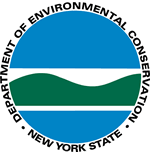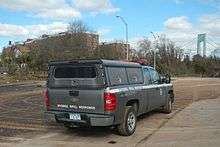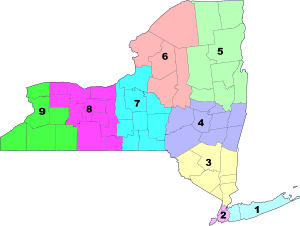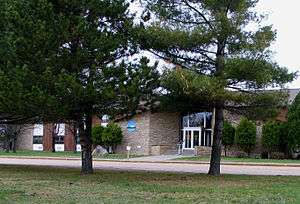New York State Department of Environmental Conservation
 DEC logo | |
| Department overview | |
|---|---|
| Formed | April 22, 1970 |
| Preceding agencies |
|
| Jurisdiction | New York |
| Headquarters | Albany, New York |
| Employees | 3,000 |
| Annual budget | $899 million (2013-14)[2] |
| Department executive |
|
| Key document | |
| Website |
www |
The New York State Department of Environmental Conservation (NYS DEC, DEC, or EnCon) is a department of the New York state government.[4] The department guides and regulates the conservation, improvement, and protection of New York's natural resources; manages Forest Preserve lands in the Adirondack and Catskill parks, state forest lands, and wildlife management areas; regulates sport fishing, hunting and trapping; and enforces the state's environmental laws and regulations. Its regulations are compiled in Title 6 of the New York Codes, Rules and Regulations. It was founded in 1970, replacing the previous Conservation Department.[5]
NYS DEC had an annual budget of about $899 million for 2013-14,[2] and employs roughly 3,000 people across New York State. It manages over four million acres (16,000 km2) of protected state-owned land and another 910,000 acres (3,700 km2) of privately owned land on which it holds conservation easements. The department's activities go beyond land management and environmental enforcement to include the publication of a magazine and a state bird atlas, and the operation of 52 campgrounds in the Adirondack and Catskill Parks.
History
Predecessor agencies
_cover.tif.jpg)
Many of the specific functions of today's DEC began as tasks carried out by individual commissions or agencies created for those specific purposes. These smaller entities merged over time to create today's department, which was officially created in 1970.[6]
The earliest New York state commission dedicated to natural resources was a three-member Fisheries Commission established in 1868. The Forest Commission, set up in 1885 and revised in 1893, was established to oversee the newly created Forest Preserve in the Adirondacks and Catskills, in addition to management of other forests, tree plantings, and forest fires elsewhere in the state. A Forest Preserve Board was also established in 1897, charged with purchasing new state lands for conservation. The Fisheries Commission and the Forest Commission were merged to form the Fisheries, Game, and Forest Commission in 1895; it was renamed the Forest, Fish, and Game Commission in 1900.[6]
Protection of New York's water resources by a state agency began in 1902 with the establishment of the Water Storage Commission, which became the Water Supply Commission in 1905. The new Water Supply Commission also absorbed the River Improvement Commission that had been created in 1904. The Water Supply Commission's duties focused on ensuring adequate water was available for New York's cities, towns, and villages.[6]
In 1911, the Water Supply Commission, the Forest Preserve Board, and the Forest, Fish, and Game Commission were combined to create the Conservation Commission, which was headed by three commissioners charged with managing inland waters, lands and forests, and fish and game, respectively.[6]
The Conservation Commission became the Conservation Department in 1926, following a major re-organization of New York State's government. The new Conservation Department also absorbed the duties of the Water Power Commission (created in 1921) and the Water Control Commission (created in 1922), which were established to monitor the state's hydro-power resources and regulate water flow.[6] The new department also included a Division of Parks, which was made senior to the State Council of Parks that had been established in 1924 to oversee New York's state parks and historic sites outside of the Forest Preserve.[7][8]
Origin
The New York State Department of Environmental Conservation was created in 1970 by legislation symbolically signed on the first Earth Day by then-Governor Nelson Rockefeller. The new department was charged with the functions of the former Conservation Department, in addition to the duties of several programs previously part of the state's Department of Health and other commissions; several brand-new offices were created as well.
The same legislation relieved the new department of the duties of the former Conservation Department's Division of Parks; the jurisdiction of the former division instead became the independent New York State Office of Parks, Recreation and Historic Preservation.[7]
1970s
In its first decade, it took the lead in helping the state comply with newly passed federal environmental legislation. DEC's work at Love Canal helped draw national attention to the problems posed by hazardous waste sites. It also worked to end General Electric's discharge of PCBs into the Hudson River, an issue that continues into the present day. It implemented New York's first state-level endangered species list.
DEC also was put in charge of reviewing declarations filed under the State Environmental Quality Review Act (SEQRA), which mirrors federal laws. In 1972, voters approved the Environmental Quality Bond Act, which continues to provide funds for land acquisition, solid waste aid, sewage treatment, air pollution control and resource recovery. Its renewal in 1986 made possible remediation of many hazardous waste sites.
1980s
In the 1980s, DEC was given regulatory authority over storage, transportation, treatment and disposal of hazardous wastes. In this capacity, it helped New York end disposal of radioactive waste at West Valley. The legislature also passed a bottle bill, to be enforced and administered by DEC. The department's facilities at Whiteface and Mt. Van Hoevenberg near Lake Placid were venues for several events at the 1980 Winter Olympic Games.
The decade also saw the department complete, with considerable volunteer help, New York's Atlas of Breeding Birds, a mammoth, exhaustive tome of great interest to birders and ornithologists. DEC efforts have also led to the restoration of several species in the state, including the bald eagle.
The state also began allowing its taxpayers to return a Gift to Wildlife on their income tax forms, providing money directly to DEC for conservation programs.
1990s
DEC actions against New York City led to a consent order requiring the city to operate the Fresh Kills landfill under its regulations, which led to its eventual closure. New York has seen an 80% reduction in its operating landfills since 1984. The department also obtained a memorandum of understanding with the city that eventually led to both tougher land-use regulations in the watersheds of its upstate reservoirs and economic development funds for the communities in them.
The 90 mile (140 km) Genesee Valley Greenway was created during this time on abandoned railbed and Genesee Valley Canal property. A new source of funding was opened up when the legislature created the state's Environmental Protection Fund.
The decade that saw New York come under its first Republican administration in 16 years had some worried that DEC would become more submissive to business interests. But the department remained active, taking the lead in establishing the state's Open Space Plan for future land acquisitions.
2000–present

The summer of 2001 brought a major change to the Department. Since its inception in 1970 the department's headquarters (central office) had been at 50 Wolf Road in Colonie, NY (the current headquarters of the New York State Department of Transportation). In the late 1990s then Gov. George Pataki decided the department needed a new home with views of the Hudson River. He authorized funding to build a new office tower at 625 Broadway in downtown Albany. The building was completed in April 2001 and by late August the approximately 1,500 central office DEC staff had been relocated to the new facility.
DEC employees were active in the cleanup after the September 11, 2001, terrorist attacks in New York City.
In 2006, the DEC started an investigation of the former New York National Guard training range, known as Camp O'Ryan. The concerns at this site included lead contamination from spent bullets, as well as alleged witnessed burial of cylinders of unknown origin. As of that date, DEC was contacting the New York Division of Military and Naval Affairs and the Army Corps of Engineers for further information about the range.
Organization
The Department of Environmental Conservation is headed by a Commissioner appointed by the governor. He or she reports to the deputy secretary for the environment. Below the commissioner and deputy commissioner are the heads of all offices, divisions, and regional directors.
The Department has 12 offices: Administration; Air Resources, Climate Change & Energy; Communications; General Counsel; Hearings and Mediation Services; Internal Audit and Investigation; Legal Affairs; Natural Resources; Public Protection; Regional Affairs and Permitting; Remediation and Materials Management; and Water Resources. Many of these offices have internal divisions with specific responsibilities.[9]
- Office of Administration
There are three divisions within this office:
- Division of Operations According to its mission statement, this division "provide(s) technical services, facilities management, and maintenance of physical assets to insure effective and efficient operation of the Department and safe public use of DEC lands and facilities." In practice this means its primary responsibility is operating DEC-owned recreational facilities such as the DEC's 52 campgrounds in the Adirondack and Catskill Parks. Other responsibilities include managing DEC's extensive vehicle fleet and all departmental facilities. It also houses DEC's internal design and construction shop.
- Division of Management and Budget: Handles all personnel, internal accounting and bookkeeping activities.
- Office of Employee Relations: Handles all relations between DEC and the several unions which represent its employees.
- Office of Air Resources, Climate Change & Energy
- Division of Air Resources Oversees all air quality-related programs
- Climate Change Office
- Office of Communications
- Office of Communication Services Responsible for all public outreach efforts, including the New York State Conservationist magazine and the Department's website.
- Press Office
- Office of General Counsel
This is DEC's legal office. It has four divisions.
- Environmental Justice
- Freedom Of Information Law (FOIL)
- Program and Regional Counsel
- Office of Hearings and Mediation Services
This office administers all DEC public hearings and enforcement hearings. It also considers all appeals of denials of requests under New York's Freedom of Information Law.

- Office of Internal Audit and Investigation
- Office of Legislative Affairs
This office serves to "build and maintain positive working relationships with Legislators and their staffs in order to encourage dialogue and cooperation on matters affecting environmental policy. OLA is charged to present, discuss, and gain passage of the Department's annual legislative program. OLA also serves as a liaison between elected officials and the Department on concerns and issues affecting their constituents."
- Office of Natural Resources
This office handles most of DEC's conservation-related functions.
- Division of Fish, Wildlife and Marine Resources: Oversees hunting, fishing and trapping licenses, and monitors the quality of those resources. Manages state wildlife management areas. Oversees freshwater and tidal wetlands programs.
- Division of Lands and Forests : Responsible for the management, protection and recreational use of about four million acres (16,000 km²) of state owned land or 13 percent of the land area of New York State. Lands and Forests is also responsible for public recreation rights on roughly 910,000 acres (3,000 km²) of Conservation easement lands. One of the largest divisions in terms of scope.
- Office of Public Protection
This office houses the two uniformed law enforcement agencies under DEC's aegis.
- Division of Forest Protection: New York State Forest Rangers.
- Division of Law Enforcement: Environmental Conservation Officers, known as ECOs for short, are the oldest state-level police agency in New York, having evolved from the state's game wardens in the late 19th century. Today they not only handle those responsibilities but enforce other environmental laws as well.
- Emergency Response Coordination Unit
- Office of Regional Affairs and Permitting
- Division of Environmental Permits
- Regions 1-9 Administration
- Office of Remediation and Materials Management

- Division of Environmental Remediation Administers cleanup efforts, spill response and brownfield redevelopment.
- Division of Mineral Resources Oversees all programs related to mining and oil and gas exploration (New York has 12,600 active wells).
- Division of Materials Management Oversees all programs related to waste management and the manufacture, transport and disposal of hazardous material.
- Office of Water Resources
- Division of Water : Oversees all water quality and flood control programs on the state's 52,337 miles (84,210 km) of rivers; 7,849 lakes; 2.5 million acres (10,000 km²) of freshwater wetlands and 25,000 acres (100 km²) of tidal wetlands. Oversees the Coastal Erosion Hazard Area [CEHA] program.
- Hudson River Estuary Program
- Great Lakes Program
- New York City Watershed
Regions



DEC divides the state into nine administrative regions, all groups of counties. All DEC Program areas are represented in each regional office. Some regions have sub-offices closer to particular DEC program areas.
- Region 1: Long Island (Nassau and Suffolk counties). Regional office is in Stony Brook.
- Region 2: New York City (The Bronx, Brooklyn, Manhattan, Queens and Staten Island). Regional Office is in Long Island City.
- Region 3: Lower Hudson Valley (Dutchess, Orange, Putnam, Rockland, Sullivan, Ulster and Westchester counties). Regional office is in New Paltz, with a sub-office in White Plains.
- Region 4: Capital Region/Northern Catskills (Albany, Columbia, Delaware, Greene, Montgomery, Otsego, Rensselaer, Schenectady and Schoharie counties). Regional office is in Schenectady, with a sub-office in Stamford.
- Region 5: Eastern Adirondacks/Lake Champlain (Clinton, Essex, Franklin, Fulton, Hamilton, Saratoga, Warren and Washington counties). Regional office is in Ray Brook, with sub-offices in Northville and Warrensburg.
- Region 6: Western Adirondacks/Lake Ontario (Herkimer, Jefferson, Lewis, Oneida and St. Lawrence counties). Regional office is in Watertown, with sub-offices located in Cape Vincent, Herkimer, Lowville, Potsdam and Utica.
- Region 7: Central New York (Broome, Cayuga, Chenango, Cortland, Madison, Onondaga, Oswego, Tioga and Tompkins counties). Regional office is in Syracuse, with sub-offices in Cortland, Kirkwood and Sherburne.
- Region 8: Western Finger Lakes (Chemung, Genesee, Livingston, Monroe, Ontario, Orleans, Schuyler, Seneca, Steuben, Wayne and Yates counties). Regional office is in Avon with sub-offices in Bath and Horseheads.
- Region 9: Western New York (Allegany, Cattaraugus, Chautauqua, Erie, Niagara and Wyoming counties). Regional office is in the City of Buffalo, with sub-offices in Allegany, Almond and Dunkirk.
Financing
Licensing and permitting fees provide the DEC with the majority of its primary operating revenue, at about 58%. Direct funding from the state contributes another 24%, and federal programs and grants make up the remaining 17% difference.
Employees
DEC employees range from holders of multiple advanced degrees to clerk/typists who may not even have attended college. They do their work everywhere from the agency's offices to deep wilderness. Almost all DEC positions are classified as civil service and require that applicants pass the appropriate exams to be considered for hiring.
ECOs and forest rangers are considered police officers under New York's Criminal Procedure Law, with the authority to carry firearms at all times and make arrests for any possible criminal violations they witness.
The majority of employees are unionized, with white collar professionals paying dues to the Public Employees Federation, blue-collar workers represented by the Civil Service Employees Association and the law enforcement officers members of the independent New York State Correctional and Police Officers' Benevolent Association, following the same pattern as other state agencies.
Frequent interagency partners
DEC frequently works closely on some matters with other agencies at different levels of government.
- The United States Environmental Protection Agency (EPA). DEC's Hudson River drillings were used by EPA as a basis for its own tests that led to its decision to dredge the PCBs from the bed of the upper Hudson.
- New York's Office of Parks, Recreation and Historic Preservation (OPRHP) is the agency in charge of New York's state parks, while DEC manages other lands. The two sometimes collaborate on projects such as the Genesee Valley Greenway, where neither agency has the expertise or jurisdiction to realize the project on its own.
- The Palisades Interstate Park Commission, which manages many of the state parks in the downstate region. Projects like the proposed Catskill Interpretive Center are to be built on land owned by PIPC since New York's state constitution is generally interpreted to preclude DEC or other state agencies from doing such things on state-owned land inside the Adirondack or Catskill parks.
- The New York City Department of Environmental Protection (DEP) is in charge and control of the city's water resources, mainly the upstate reservoirs, manages the city's storm water and sewage systems, has jurisdiction over air and noise pollution within the city, and responds to emergencies caused by releases or threatened releases of hazardous substances into the environment. Most of DEP's activities take place within DEC's Region 2.
- The Adirondack Park Agency has final authority over most private land use in that park.
See also
- New York State Department of Environmental Conservation Police
- List of New York state forests
- List of New York wild forests
- List of New York state wildlife management areas
References
Notes
- ↑ "Department of Environmental Conservation," New York State Archives, n.d. Accessed: October 6, 2016.
- 1 2 New York State Division of the Budget. 2014. "Agency Appropriations". Accessed October 6, 2016.
- ↑ "State Senate Confirms Basil Seggos as the New DEC Commissioner". NYS Department of Environmental Conservation. 15 June 2016. Retrieved 16 July 2016.
- ↑ Environmental Conservation Law § 3-0101. "The Department of Environmental Conservation, which was established by chapter 140 of the Laws of 1970, is hereby continued, and all the powers, functions, duties and obligations possessed by the department pursuant to such chapter immediately preceding the effective date of this chapter are hereby continued."
- ↑ "History of DEC". New York State Department of Environmental Conservation. Retrieved 15 November 2010.
- 1 2 3 4 5 "Environmental Documentary Sources in New York State" (PDF). New York State Education Department, New York State Archives. August 2000. pp. 23–25. Retrieved October 23, 2016.
- 1 2 "Environmental Documentary Sources in New York State" (PDF). New York State Education Department, New York State Archives. August 2000. pp. 15–16. Retrieved October 23, 2016.
- ↑ Natural Heritage Trust; New York State Office of Parks, Recreation and Historic Preservation; New York State Council of Parks & Recreation (1975). Fifty Years: New York State Parks, 1924-1974. Natural Heritage Trust. p. 16.
- ↑ About the DEC
Further reading
- New York State Department of Environmental Conservation, "History of the New York State Department of Environmental Conservation".
- 2006-07 NYS DEC proposed budget
External links
| Wikimedia Commons has media related to New York State Department of Environmental Conservation. |
- Official website
- Department of Environmental Conservation in the New York Codes, Rules and Regulations
- "Joe Martens: Commissioner of the New York Department of Environmental Conservation," SUNY-ESF, n.d.